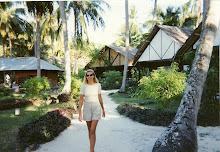2009/2010 was a horrible winter here in Provence. Long, dull, exceptionally cold and rainy. The light, sunny days were very few and everyone seemed to be in low spirits.
It wasn't till the end of March that we started to see a bit more light and even then it was far from warm. We started to prune the oliviers round here on the 29th of March.
My neighbours were busy from morning till night with hundreds of mature olive trees that needed detailed attention.
My own oliviers are a mix of trees which emerged slowly from the ruins of trees killed by the long hard frost in 1956, and new young trees I planted in 2006. The younger and older trees need to be pruned differently. For the more established, taller trees I cut away suckers from aournd the roots to favour the three or four main charpentes and then used secateurs to remove branches growing into 'the middle' of each tree. Thinning and opening the olivier out in this way lets the sun in and olive trees love the sun. I also removed the few small branches with diseased leaves on them and little dry twigs that were dead.
For the younger, smaller trees, the first thing to do was to stand back and look at each one. Then you circle it; again, just looking. Once you've taken in the shape and balance of the tree you look into the middle and remove any superfluous charpentes, cutting at the centre where the branch begins. You should leave three or four charpentes. These will forever form the tree's basic framework. You then remove any branches which are trailing on or too near the ground and branches which cross others within the tree's centre.
Grass and weeds need to be cleared away from around the base of each olivier. The space cleared can be as wide or a little wider than a young tree. I'll put a mix of horse manure and straw down soon. This comes from a friend of a friend who keeps horses. It is entirely natural, without the weird industrial chemicals that go into commercial fertilisers. The horses graze on healthy, untreated grass in a rural area without crops nearby - no chemicals are sprayed around them. The animals aren't treated with anti-biotics. I don't treat the trees either so the olives and the eventual olive oil are pure and simple - non-traitéé.
The other task is to gather up all the pruned twigs and branches and burn them. That needs caution in this forested area. The pompiers quite rightly enforce the periods when you can't burn anything in the open.
And after that the trees need 40 litres of water each, twice monthly. That's usually provided by a mix of me dragging the extended hose up to the trees and the spectacular summer thunderstorms which often save me the hassle.
Wednesday, March 31, 2010
Subscribe to:
Post Comments (Atom)

Do you have an estimate as to when to pick the olives this year?
ReplyDeleteI come from England to do this great task and am wondering about the best weekend to book my trip this year, given the cold, late spring.
Thanks.
I, of course, a newcomer to this blog, but the author does not agree
ReplyDelete